The tragic incident involving Border Patrol agent Brian Terry in 2010 prompted a reevaluation of border security measures in Arizona. In response, authorities implemented a range of enhancements aimed at increasing safety and preventing similar events, including improved surveillance, personnel training, and stricter firearms regulations. However, the deployment of these new measures encountered challenges such as budget constraints and political opposition, complicating efforts to bolster security along the U.S.-Mexico border.
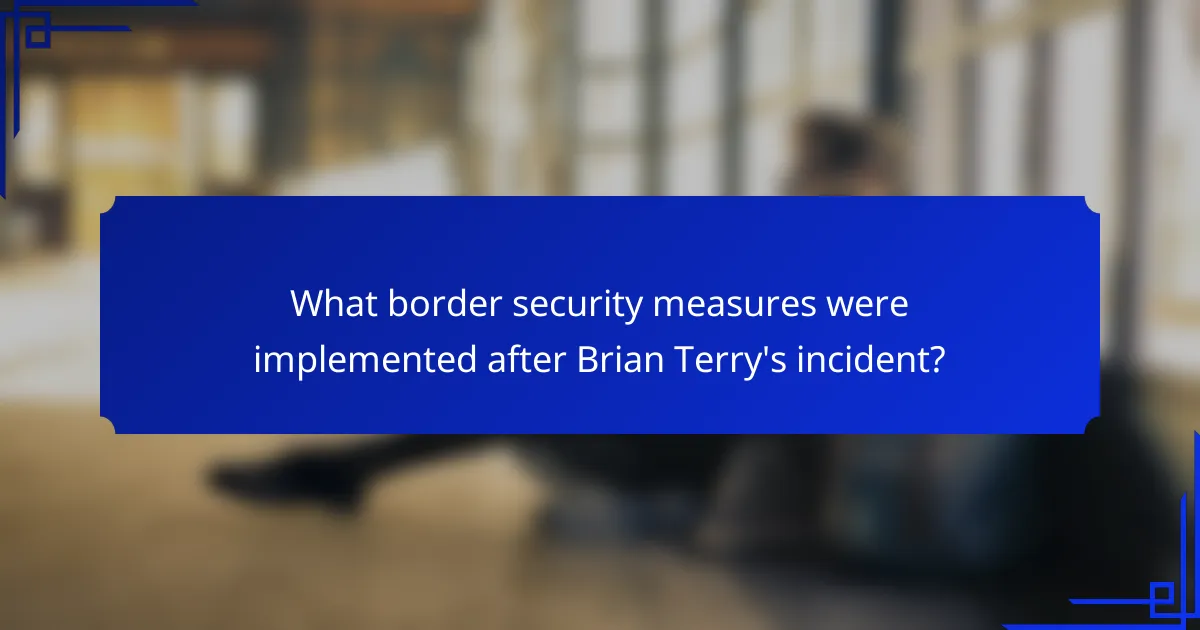
What border security measures were implemented after Brian Terry’s incident?
After Brian Terry’s incident, several border security measures were implemented to enhance safety and prevent similar occurrences. These measures focused on increasing surveillance, improving personnel training, enforcing stricter firearms regulations, collaborating with local law enforcement, and enhancing intelligence sharing.
Increased surveillance technology
In response to the incident, border security agencies invested in advanced surveillance technology, including drones, motion sensors, and high-resolution cameras. These tools allow for real-time monitoring of border areas, making it easier to detect illegal activities and respond promptly.
Agencies also integrated satellite imaging and thermal imaging systems to enhance visibility in remote areas, which can be critical during nighttime operations. This technological upgrade has significantly improved situational awareness along the border.
Enhanced personnel training
Training programs for border security personnel were revamped to include more comprehensive modules on tactical response, conflict de-escalation, and legal protocols. This ensures that agents are better prepared to handle high-stress situations effectively and safely.
Regular drills and simulations are now part of the training regimen, allowing personnel to practice responses to various scenarios they may encounter in the field. This hands-on approach has proven beneficial in enhancing operational readiness.
Stricter firearms regulations
Following the incident, stricter firearms regulations were enacted to control the types of weapons that could be carried by border agents. This includes mandatory background checks and restrictions on certain high-capacity firearms.
These regulations aim to ensure that agents are equipped with appropriate firearms while minimizing the risk of misuse. Training on responsible firearm handling and usage has also been emphasized to promote safety among personnel.
Collaboration with local law enforcement
Collaboration between federal border security agencies and local law enforcement has been strengthened to enhance overall border security. This partnership facilitates information sharing and coordinated responses to incidents that may arise near the border.
Joint task forces have been established to tackle cross-border crime, allowing for a more unified approach to security challenges. This cooperation helps leverage local knowledge and resources, making operations more effective.
Improved intelligence sharing
Intelligence sharing among various agencies was significantly improved post-incident, with the establishment of secure communication channels. This allows for timely dissemination of critical information regarding potential threats or suspicious activities.
Agencies now regularly participate in intelligence briefings and collaborative assessments, which enhances their ability to anticipate and respond to border security challenges. This proactive approach is essential for maintaining safety and security along the border.
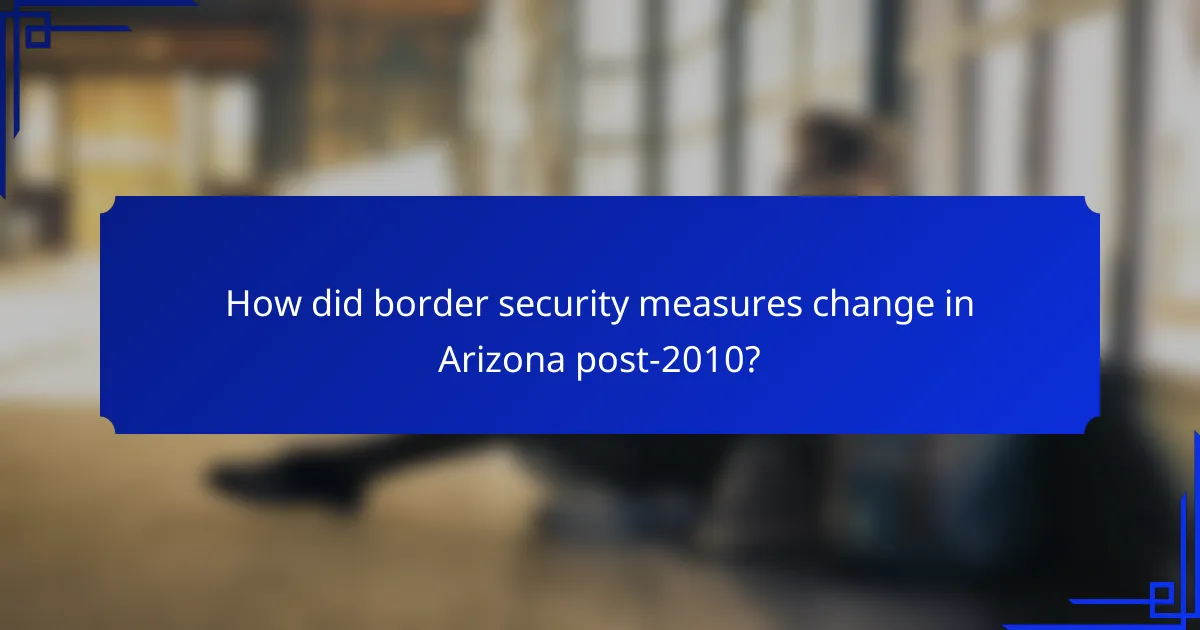
How did border security measures change in Arizona post-2010?
Following the tragic incident involving Border Patrol agent Brian Terry in 2010, Arizona implemented significant changes to its border security measures. These adjustments aimed to enhance safety and control along the U.S.-Mexico border, focusing on personnel, technology, and physical barriers.
Deployment of additional Border Patrol agents
In response to increasing security concerns, Arizona saw a substantial increase in the number of Border Patrol agents deployed to the region. This expansion was part of a broader strategy to improve surveillance and response capabilities along the border.
By adding agents, the U.S. Customs and Border Protection aimed to create a more visible presence, which can deter illegal crossings and enhance the overall effectiveness of border enforcement. The increase in personnel also allowed for better coverage of remote areas that were previously difficult to monitor.
Introduction of drone surveillance
The adoption of drone surveillance marked a significant technological advancement in border security measures post-2010. Drones equipped with high-resolution cameras and sensors provided real-time aerial monitoring, enabling agents to track illegal activities more effectively.
This technology allows for rapid deployment in response to detected movements, covering vast areas quickly and efficiently. Drones have proven particularly useful in monitoring rugged terrains where traditional patrols may struggle to operate.
Expansion of fencing and barriers
Arizona also experienced an expansion of fencing and barriers along critical sections of the border. This physical infrastructure was designed to impede unauthorized crossings and funnel individuals toward designated entry points.
The barriers vary in design and height, with some areas featuring reinforced fencing while others utilize vehicle barricades. The effectiveness of these barriers is often debated, but they serve as a crucial component of the overall border security strategy, aiming to reduce illegal entry and enhance safety for both agents and local communities.
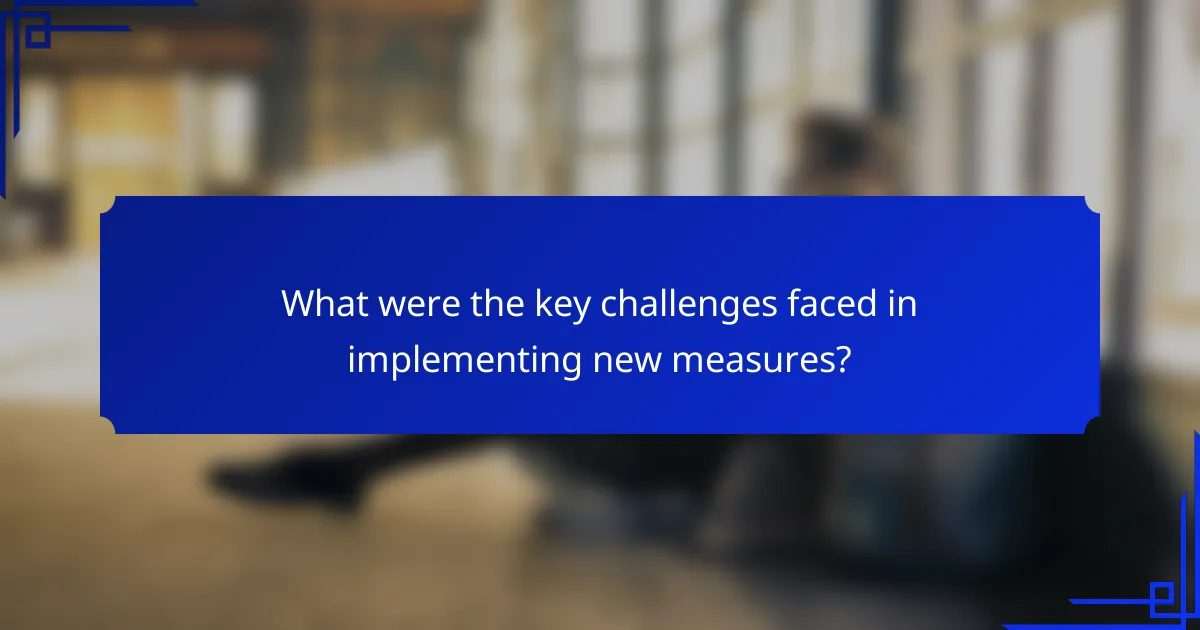
What were the key challenges faced in implementing new measures?
Implementing new border security measures after Brian Terry’s incident faced several key challenges, including budget constraints, political opposition, and community resistance. These factors complicated the deployment of effective strategies aimed at enhancing safety and operational efficiency.
Budget constraints
Budget constraints significantly hindered the ability to implement comprehensive border security measures. Funding for new technologies, personnel training, and infrastructure upgrades often fell short, limiting the scope of enhancements. For instance, while some agencies sought millions in additional funding, they frequently received only a fraction of their requests.
To navigate budget limitations, agencies often prioritized essential upgrades over comprehensive solutions. This meant focusing on immediate needs like surveillance systems rather than long-term infrastructure projects, which could delay overall improvements.
Political opposition
Political opposition emerged as a major hurdle in advancing new border security initiatives. Different political factions often disagreed on the best approaches, leading to legislative gridlock. For example, proposals for increased funding or new policies faced pushback from those advocating for immigration reform or reduced enforcement.
To overcome political challenges, stakeholders must engage in dialogue and seek bipartisan support. Building coalitions that emphasize shared goals, such as public safety and community welfare, can help bridge divides and facilitate more effective policy implementation.
Community resistance
Community resistance to new border security measures often stemmed from concerns about civil liberties and local impacts. Residents in border areas sometimes feared that increased enforcement would lead to racial profiling or strained community relations. This apprehension made it difficult to gain local support for proposed initiatives.
Addressing community concerns requires transparency and active engagement. Agencies should hold public forums to explain the benefits of new measures and listen to local feedback. Building trust through open communication can help mitigate resistance and foster a collaborative approach to border security.
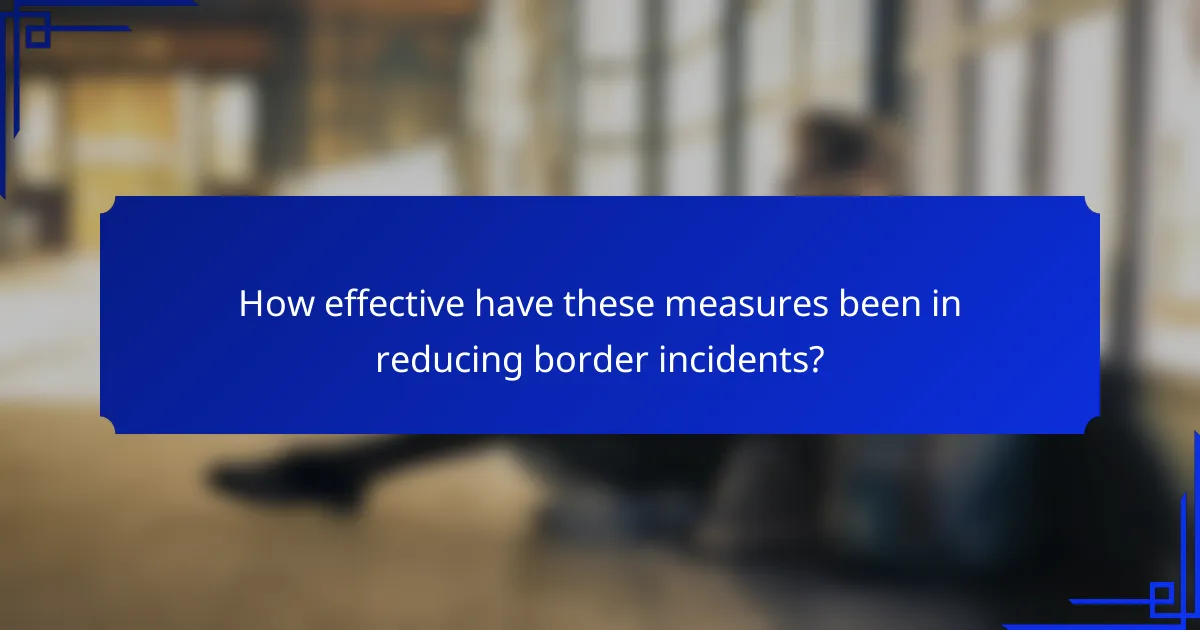
How effective have these measures been in reducing border incidents?
Border security measures implemented after Brian Terry’s incident have shown varying degrees of effectiveness in reducing border incidents. Overall, there has been a notable decline in illegal crossings, violent confrontations, and smuggling activities, indicating that these measures have had a positive impact.
Statistical decrease in illegal crossings
Since the introduction of enhanced border security measures, illegal crossings have decreased significantly. Reports indicate that the number of unauthorized entries has dropped by approximately 30-50% in certain regions, reflecting the effectiveness of surveillance technologies and increased personnel at border checkpoints.
Factors contributing to this decline include the deployment of advanced monitoring systems and increased patrols, which deter potential crossers. Additionally, public awareness campaigns have educated individuals about the risks associated with illegal crossings.
Reduction in violent confrontations
There has been a marked reduction in violent confrontations along the border, with incidents reportedly down by around 40% since the implementation of stricter security protocols. Enhanced training for border agents and improved communication systems have played crucial roles in minimizing conflicts.
Moreover, the establishment of clear engagement rules has helped agents manage potentially dangerous situations more effectively, reducing the likelihood of violence. This shift not only protects border personnel but also enhances safety for individuals attempting to cross.
Increased arrests of smugglers
Border security measures have led to a significant increase in the arrests of smugglers, with estimates suggesting a rise of 25-60% in apprehensions. Enhanced intelligence-sharing and collaboration between agencies have improved the identification and capture of smuggling operations.
Targeted operations and the use of technology, such as drones and surveillance cameras, have allowed law enforcement to disrupt smuggling networks more efficiently. This proactive approach not only deters smuggling but also contributes to overall border security and safety.
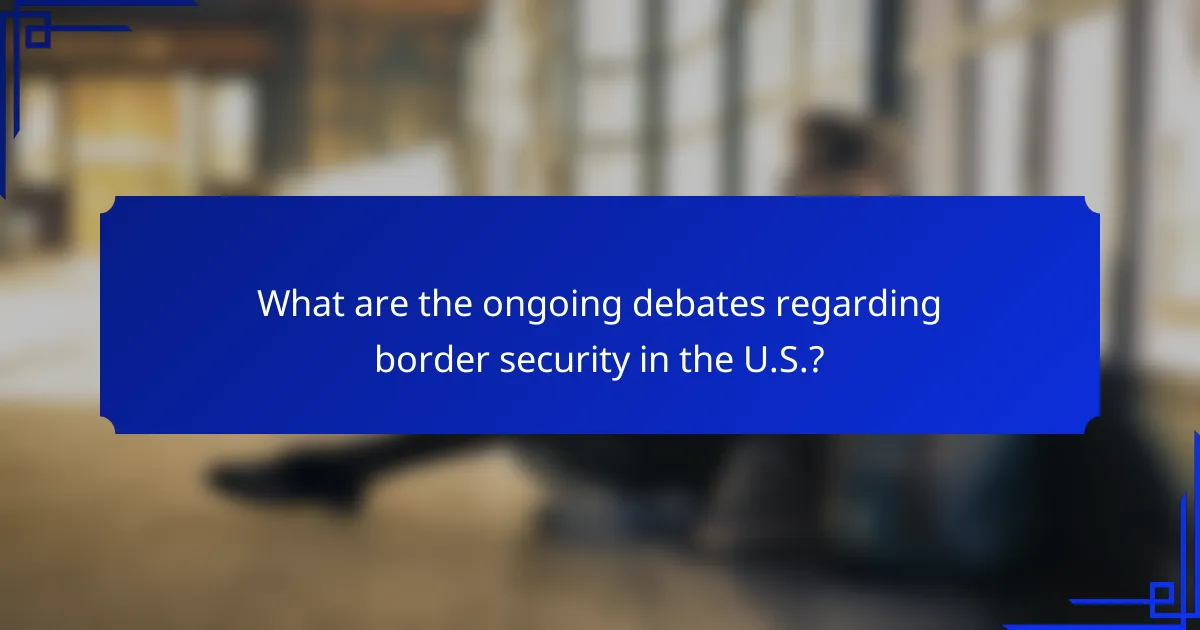
What are the ongoing debates regarding border security in the U.S.?
The ongoing debates about U.S. border security center on how to effectively protect the nation’s borders while addressing humanitarian issues and immigration policies. These discussions often involve balancing the need for safety with the rights and needs of migrants seeking asylum or better opportunities.
Balancing security and humanitarian concerns
Border security measures must consider both the safety of the nation and the humanitarian needs of individuals fleeing violence or poverty. Stricter security protocols can lead to increased risks for vulnerable populations attempting to cross borders, resulting in tragic outcomes.
Policymakers face the challenge of implementing effective security without compromising the humane treatment of migrants. Solutions may include enhanced training for border personnel on human rights and the establishment of safe zones for asylum seekers.
Impact of immigration policies
Immigration policies significantly influence border security dynamics. Policies that are overly restrictive can lead to increased illegal crossings and strain on border resources, while more lenient approaches may encourage higher migration rates.
For example, the Deferred Action for Childhood Arrivals (DACA) program has led to discussions about the need for comprehensive immigration reform. Effective policies should aim to streamline legal pathways for immigration while ensuring that border security remains robust and effective.
